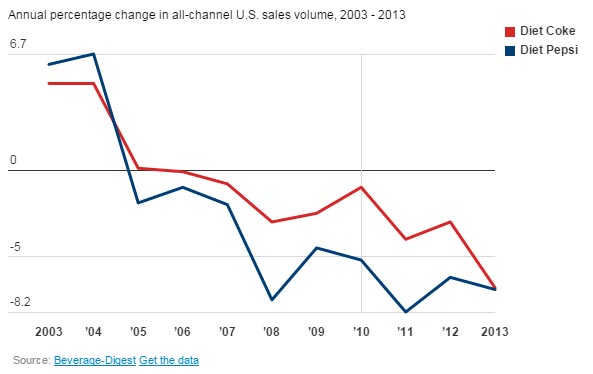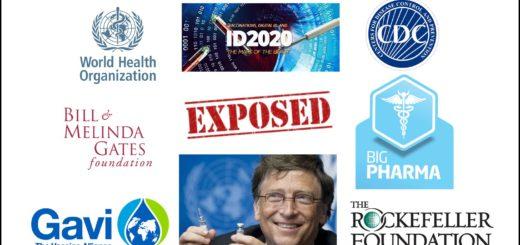By Dr. Mercola
Soda and other sweetened beverages have no redeeming nutritional value, and ditching them from your diet can go a long way toward improving your health.
One 20-ounce bottle of cola contains the equivalent of about 16 teaspoons of sugar in the form of high fructose corn syrup (HFCS), which will cause your insulin to spike within 20 minutes of drinking it.Your liver responds to this insulin burst by turning massive amounts of sugar into fat, most of which is stored — hence the weight gain associated with a high-sugar diet.
But a chronically elevated insulin level (which you definitely have if you drink soda on a regular basis) is also a foundational factor of most chronic disease, from diabetes to cancer.
Sugary Beverages Tied to Increased Risk of Diabetes
Obesity, lack of exercise, and family history of the disease are among the risk factors for type 2 diabetes. However, your diet is perhaps the greatest predictor of diabetes, and sugary beverages like soda can play a major role.
Consumption of soft drinks has repeatedly been identified as a risk factor for weight gain and diabetes.Most recently, British researchers1,2,3,4 investigated whether sugary beverages, fruit juice, and “diet” beverages could still influence the risk of type 2 diabetes even after controlling for the risk factor of obesity — meaning, can they increase your risk of type 2 diabetes even if you’re not obese?
The meta-analysis included 17 observational studies involving more than 38,250 cases of type 2 diabetes, all of which reported consumption of sugary drinks, fruit juice, and artificially sweetened beverages. None of the studies were funded by industry.
According to the authors:
“Higher consumption of sugar sweetened beverages [one 250 ml serving per day or higher] was associated with a greater incidence of type 2 diabetes, by 18 percent per one serving/day and 13 percent before and after adjustment for adiposity[i.e. body fat]…
[F]or artificially sweetened beverages, 25 percent and 8 percent… and for fruit juice, 5 percent and 7 percent.
Potential sources of heterogeneity or bias were not evident for sugar sweetened beverages. For artificially sweetened beverages, publication bias and residual confounding were indicated.
For fruit juice the finding was non-significant in studies ascertaining type 2 diabetes objectively.” [Emphasis mine]
The researchers estimate that over a period of 10 years, cutting consumption of sugary beverages could reduce the number of new cases of diabetes by nearly two million in the US, and by 80,000 in the UK.
They also note that while there appears to be bias and confounding factors influencing the results of artificially sweetened drinks, “neither artificially sweetened beverages nor fruit juice are suitable alternatives to sugar-sweetened beverages for the prevention of type 2 diabetes.”
‘Diet’ Drinks Worsen Obesity and Diabetes
To “help” diabetics and those struggling with their weight, the beverage industry has created a large niche of “diet” beverages, sweetened with artificial no- or low-calorie sweeteners.
However, since the advent of artificial sweeteners, rates of obesity and diabetes have continued to climb,5 and research over the past 30 years has repeatedly shown they have very similar effects as regular sugar, promoting both obesity and diabetes.
Some studies have even demonstrated that artificial sweeteners worsen diabetes and obesity to a greater degree than regular sugar and HFCS.6
For example, one 2012 study7 found that saccharin and aspartame both cause greater weight gain than sugar, even when the total caloric intake remains similar.
Research8,9 published the following year highlighted the fact that diet soda drinkers suffer the same exact health problems as those who opt for regular soda, including excessive weight gain, type 2 diabetes, cardiovascular disease, and stroke.
For even more research showing that artificial sweeteners promote obesity, type 2 diabetes and other health problems, please see this previous aspartame article.
The weight of the evidence is clear enough at this point that advertising artificially sweetened foods and beverages using the word “diet” is grossly misleading.
Use of the Word ‘Diet’ in Promotion of Weight-Boosting Products is Deceptive and False
False advertising is prohibited by federal law, and the term “diet” is only permitted on brands or labels when it is not false or misleading. “Diet” implies it’ll help you lose weight, but science clearly refutes the accuracy of such claims.
In light of that, the consumer group US Right to Know (US RTK) has asked the Federal Trade Commission (FTC) and the Food and Drug Administration (FDA) to investigate Coca-Cola Co., PepsiCo. Inc., and other companies for false advertising.10,11,12
On July 1, US RTK followed up with another letter13 to the FDA, urging the agency to stop Coca-Cola Company from making “illegal claims that its artificially sweetened sodas prevent, mitigate, or treat obesity.”
Coca-Cola Company recently announced14 that its number one “global commitment to fighting obesity” is to “offer low- or no- calorie beverage options in every market.”
But if artificially sweetened beverages promote obesity rather than fight it — which research clearly indicates it does — then Coca-Cola’s commitment is anything but helpful. Nor is it supported by science.
As noted in the US RTK’s press release:15
“Federal law and rules allow food companies to make science-based ‘health claims’ that link a product to reduced risk of a disease, but prohibit them from making ‘disease claims,’ or claims to ‘diagnose, mitigate, treat, cure, or prevent a specific disease.’
In this case, there is growing scientific evidence tying artificial sweeteners to weight gain, not weight loss.
‘Coke is gulling consumers into believing that artificially sweetened soda is a treatment for obesity,’ said Gary Ruskin, co-director of U.S. Right to Know. ‘Coke is wrong on the facts and the FDA should stop them if they are on the wrong side of the law.'”
Are Diet Soda Drinkers Simply Trading One Hazard for Another?
On the upside, soda sales have been dwindling for a number of years now, both among regular and diet brands. According to Time Magazine,16 Diet Coke saw a seven percent decline in sales over the last three months alone, suggesting a level of increased awareness. Unfortunately, it seems many may simply be trading one diet beverage for another.
While Diet Coke is down, Coca-Cola Zero sales have risen by six percent, making up for most of the difference. Both Diet Coke and Coca-Cola Zero contain aspartame, so it’s likely people are switching due to flavor as opposed to health concerns about aspartame.17 Others are likely to get confused about Diet Pepsi’s recent “overhaul.” As of August it will no longer contain aspartame,18,19 which may appear to be another step in the right direction.
However, it’s simply being replaced with sucralose, aka Splenda,20,21 so the end result is still the same… The irony of this has not gone unnoticed. On April 26, 2015 US Right to Know tweeted:
#DietSodaScam: @PepsiCo switching from aspartame to sucralose is like rearranging deck chairs on the Titanic.
Indeed, while less widely publicized, sucralose is associated with many of the same adverse effects as aspartame, including blood sugar increases and weight gain.
Researchers have also found that sucralose can kill as much as 50 percent of your microbiome.22,23 This is very important, because when you destroy healthy intestinal bacteria you open yourself up to unfriendly micro-organisms that can cause health problems. Worse yet, sucralose appears to target beneficial microorganisms to a greater extent than pathogenic and other more detrimental bacteria. And remarkably, according to one study,24 these adverse effects on gut microbiota remained even after a three-month long recovery period.
The Role of Environmental Pollutants in Diabetes Risk
Sugary and/or artificially sweetened beverages are not the sole cause for obesity and diabetes, of course. There are many other dietary factors that contribute to the problem. I’ve become convinced that eating REAL FOOD is imperative for good health, but even in the category of whole food there are risk factors to take into consideration, courtesy of the polluted state of our world. One such example is fish. A number of analyses have been published over the years looking at the links between fish consumption and type 2 diabetes.25
While the reasons are still unclear, fish eaters appear to have an increased risk for the disease. One potential culprit appears to be environmental pollutants such as dioxins, PCBs, and chlorinated pesticides. Vietnam War veterans exposed to Agent Orange were found to have higher rates of diabetes than those who were no exposed, and researchers have proposed that persistent organic pollutants (POPs) may be a stronger risk factor for diabetes than obesity.
POPs are very persistent in the environment, including waterways and oceans, and most fish are contaminated to some degree these days. Unfortunately, POPs accumulate in fatty tissues, and fish have historically been one of the best sources of healthy fats. (As a general rule, seafood caught in Alaska and the South Pacific tend to be the safest in terms of POP contaminants.)26 According to one 2008 study:27
“The strong associations seen in quite different studies suggest the possibility that exposure to POPs could cause diabetes. One striking observation is that obese persons that do not have elevated POPs are not at elevated risk of diabetes, suggesting that the POPs rather than the obesity per se is responsible for the association. Although a specific mechanism is not known, most POPs induce a great number and variety of genes, including several that alter insulin action.”
Could Shunning Healthy Fats Play a Role in Diabetes Too?
Another dietary theory is that rising diabetes rates may be in part related to the shunning of healthy dairy fats. The saturated fat heptadecanoic acid in particular, which butter is high in, has been shown to improve metabolic syndrome in bottlenose dolphins. As reported by NewsMax:28
“To better understand what may be a driver for metabolic syndrome in dolphins, we started exploring their diet, which is primarily fish,’ said the study’s lead author Dr. Stephanie Venn-Watson… Since so many humans supplement their diets with fish-based omega-3 fatty acids, the researchers measured fatty acid blood levels in 49 dolphins as well as in the fish they ate.
‘We were surprised to find that among the 55 fatty acids studied, the saturated fat heptadecanoic acid appeared to have had the most beneficial impact on dolphin metabolism,’ said Venn-Watson.
‘Dolphins with higher levels of heptadecanoic acid in their blood had lower insulin and triglycerides.’ When dolphins with low levels of heptadecanoic acid were fed fish high in the nutrient, symptoms of metabolic syndrome, such as high insulin, glucose, and triglycerides, became normal within six months…”
Heptadecanoic acid is a saturated fat found in dairy products such as whole milk, yoghurt, and butter; rye; and certain species of fish, such as mullet. The researchers suggest that avoiding whole fat dairy may have inadvertently led to widespread deficiencies in heptadecanoic acid, and that this deficiency might be playing a role in the diabetes epidemic.
Coffee Drinkers May Have Reduced Risk of Diabetes
Since we’re talking about beverages and some of the more surprising dietary factors of diabetes, recent research found that long-term coffee drinkers were half as likely to develop type 2 diabetes compared to those who didn’t drink coffee. The researchers theorize this benefit may be due to coffee‘s ability to dampen inflammation.29
The coffee plant and its seeds (coffee beans) contain a natural blend of polyphenol antioxidants (including chlorogenic acids), bioflavonoids, vitamins, and minerals that all work together to offer some impressive health-promoting benefits, and even help neutralize the harsher effects of the caffeine that coffee naturally contains.
There are more than 1,000 different chemicals in coffee and researchers are only beginning to tease out how the synergy between them might benefit your health, but there’s at least preliminary evidence suggesting it may be helpful against diabetes. That said, if you’re going to drink coffee, make sure it’s organic, and drink it black, without sugar, artificial sweeteners, milk, or other creamers. If you add sugar or artificial sweeteners to your coffee you’ll spike your insulin levels, which is the very thing you want to avoid in order to prevent diabetes.
Choose Your Beverages Wisely
Sweetened beverages, whether it’s sweetened with sugar, HFCS, naturally-occurring fructose, or artificial sweeteners, are among the worst culprits causing obesity, diabetes, and related health problems. Remember that sweetened beverages also include flavored milk products, bottled teas, and “enhanced” water products. I’d be leery of anything listing “artificial flavors” as well — especially if the products boasts being low in sugar.Ditching ALL of these types of beverages can go a long way toward reducing your risk of weight gain and diabetes. Your best, most cost effective choice of beverage is filtered tap water. I strongly recommend using a high-quality water filtration system unless you can verify the purity of your water. Since most water sources are now severely polluted, the issue of water filtration and purification couldn’t be more important.
Seltzer or mineral water is another option. Adding a squeeze of lemon or lime is one way to add some flavor and variety, and many soda drinkers find it easier to ditch soda when replacing it with some sparkly water. Besides purification, I also believe it’s critical to drink living water. I previously interviewed Dr. Gerald Pollack about his book, The Fourth Phase of Water: Beyond Solid, Liquid, and Vapor.
This fourth phase of water is referred to as “structured water” and is the type of water found in all of your cells. This water has healing properties, and is naturally created in a variety of ways. Water from a deep spring is one excellent source of structured water, and there’s a great website called FindaSpring.com where you can find a natural spring in your area. You can also promote structured water through vortexing, i.e. stirring your water, creating a vortex in the glass or pitcher.
As for a safer sweetener option, you could use stevia or Luo Han, both of which are safe natural sweeteners. You can easily grow stevia and harvest the leaves as you need them. I ordered two small plants from Amazon and now have large stevia bushes. Just keep in mind that if you struggle with high blood pressure, high cholesterol, diabetes, or extra weight, then you have insulin sensitivity issues and would likely benefit from avoiding ALL sweeteners, including stevia and Luo Han.

















